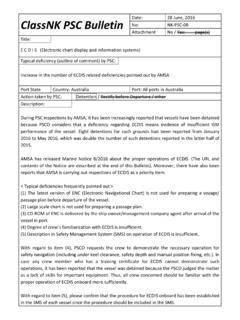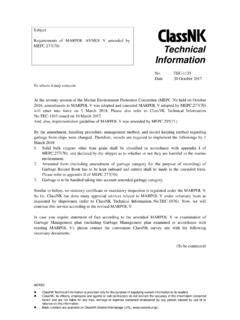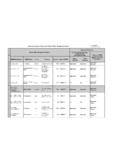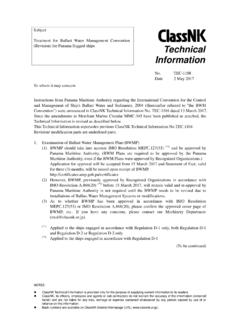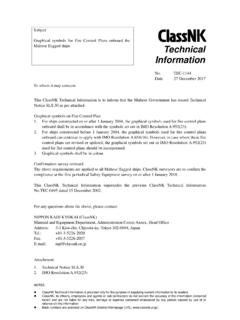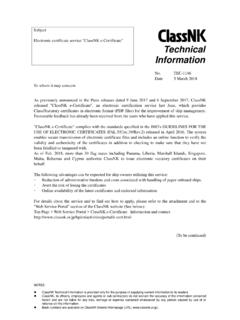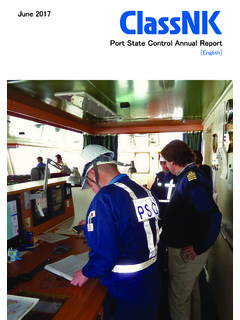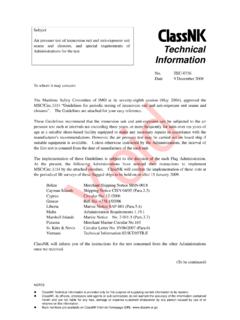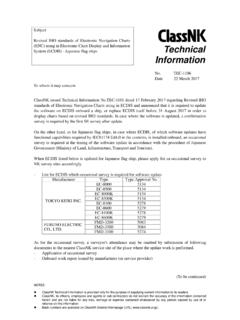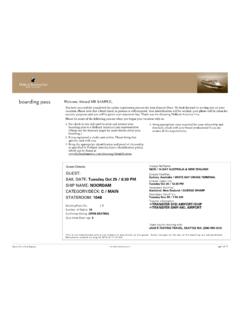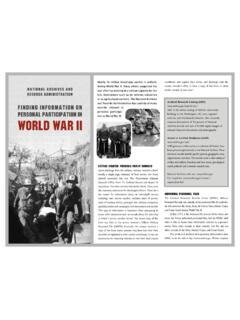Transcription of MUSTERS AND DRILLS AND ON-BOARD TRAINING & …
1 1 DEPARTMENT OF ECONOMIC DEVELOPMENT MUSTERS AND DRILLS AND ON-BOARD TRAINING & INSTRUCTION This notice explains the main requirements with respect to DRILLS , MUSTERS and TRAINING for ready reference by those affected giving affect to the latest requirements contained within SOLAS Chapter III. Documents referred to in this notice: Merchant Shipping (Life-Saving Appliances) Regulations 1999 ( 431/99) Merchant Shipping (Official Log Books) Regulations 1992 ( 363/92) Most regulations and notices are available on the Isle of Man Government web site: or by contacting Lists and Emergency Instructions. Clear instructions to be followed in the event of an emergency are to be provided for every person on board. These may be provided as a separate card or instruction booklet given to each crew member or may be a card fixed in each cabin with instructions for the occupant of the cabin or in some other equally effective manner.
2 The instructions must be in English but may additionally be in another language if this assists in providing clear information to each crew member. muster lists and Emergency Instructions must also be posted up in conspicuous places throughout the ship including at least the bridge, the engine room or engine control room, and on each accommodation deck. In passenger ships the instructions must be posted in each cabin and must be in English and also in any other language likely to be understood by a majority of the passengers. Additional emergency instructions must also be positioned at assembly stations and in public spaces to inform passengers of their assembly stations, essential actions to take and the location of lifejackets and the method of donning their lifejackets. muster lists must meet clear specific minimum requirements. They must be prepared and in place before the ship proceeds to sea and must be kept up to date whenever MSN 005 MANX SHIPPING NOTICE 2crew members change.
3 Those in cargo ships do not require approval of the Isle of Man Ship Registry but those in passenger ships must be approved and stamped as approved. The muster lists must clearly specify at least: details of the General Alarm Signal and any public address system and how it will be used. actions to be taken by crew and passengers, including any special purposes personnel; details of how an abandon ship order will be communicated if necessary; the survival craft or launching station to which each crew member is assigned; the duties assigned to different crew members including, for example; closing of openings such as watertight doors, fire doors, valves, scuppers, sidescuttles, skylights, etc. equipping and preparation and launching of survival craft; the muster of passengers; the use of communications equipment; the manning of fire parties and emergency parties do deal with other types of emergency, including, for example a man overboard; any special duties assigned to crew members in connection with fire fighting equipment and other emergency control equipment; the identity of any officer or officers assigned to ensure that fire fighting equipment and life-saving equipment is maintained; the identity of substitute personnel for key crew members.
4 In passenger ships procedures are required for locating and rescuing passengers who may be trapped in their cabins and these procedures shall be included in the muster list. Also in passenger ships the muster list must show a number of other duties associated with the safety and care of passengers including; warning passengers and providing information as well as ensuring that passengers are suitable dressed and correctly wearing their lifejackets; assembling passengers at assembly stations; keeping order in passageways and stairways. 3It is recommended that crew members assigned duties in passenger ships which bring them into contact with passengers in any emergency situation, are provided with distinctive identification in the form of hats, or jackets that they can don as soon as an emergency alarm is initiated. Thus identified, they are immediately recognizable to passengers as members of the crew with assigned duties.
5 Making up muster lists. When making up a muster list care should be taken to ensure that the duties allocated to any individual crew member do not overlap and that his duties are clear and without conflict in any foreseeable emergency. Those in charge of launching and expected to be the last to abandon ship, for example, should not be assigned to the survival craft likely to be first launched. In assigning personnel to survival craft the muster list should include a deck officer or a person certificated as Proficient in Survival Craft in charge of each survival craft, a second in command in the case of lifeboats, and a person capable of carrying out minor engine adjustments in the case of a motorised survival craft. The person assigned to be in charge of each survival craft, and his second in command should also be provided with a list of that craft s assigned crew, and is to be responsible for ensuring that the crew are familiar with their assigned duties.
6 Emergency Signals. The General Alarm signal is intended as a signal for summoning the crew and passengers to their muster stations and for initiating the emergency actions set out in the emergency instructions. This signal is one of seven or more short blasts followed by a long blast which is to be made on the ship s alarm bells or klaxons and the whistle. Most ships will have a separate Fire Alarm system which is automatically activated and which can be manually activated from various locations. This system may sound a different signal and it may only sound in selected locations. The muster list and emergency instructions must clearly describe each alarm signal used and the actions that are required on each being sounded. Emergency TRAINING and DRILLS It is a legal requirement that every crew member who is assigned to emergency duties is familiar with those duties BEFORE THE SHIP SAILS. This requirement may also be found in the STCW Convention and in the requirements of the ISM code.
7 In passenger ships, whenever passengers are to be on board for 24 hours or longer, there must be a muster of passengers within 24 hours of their joining at which time they are to be instructed in the use of lifejackets and the actions to be taken in any 4emergency. In general this muster should take place, whenever possible, before the ship sails. Whenever a new passenger or passengers join there shall be a passenger briefing before the ship sails made through the public address system or a similar effective system and supplemented if appropriate by video display facilities and similar. The briefing should cover the items required in the emergency instructions for passengers and be in English and also in any other language likely to be used by a majority of the passengers. In all ships, emergency DRILLS shall be conducted, so far as is practicable as if there was an actual emergency situation and those responsible for planning DRILLS should endeavour to ensure that the types of problems likely to occur in any real emergency are simulated as far as possible to maintain an atmosphere of realism.
8 Missing crew members including key personnel, injured crew members and inaccessible routes can all, for example, be easily simulated and pre-planned into the drill so that emergency teams become familiar with dealing effectively with unexpected problems. Every crew member MUST take part in at least:- One abandon ship drill every month. and one fire drill every month. In passenger ships there must be an abandon ship drill and a fire drill every week but it is permissible for these DRILLS not to include all the crew as long as the requirement for participation by each crew member at least once per month is met. However, it is recommended that so far as is possible the whole crew are involved on each occasion as a unified team. Whenever 25% or more of the crew have not taken part in a drill in that ship in the preceding month, as a consequence of just joining the ship or for some other reason, there must be an emergency drill within 24 hours of sailing.
9 In the case of Ro-Ro passenger ships on short voyages the requirement for DRILLS within 24 hours of 25% or more of the crew changing could permit the ship to make several voyages with passengers before all the crew have taken part in a drill. Therefore, in these ships it is required that all members of the crew are made familiar with the emergency procedures and arrangements before the ship sails. Conduct of Fire and Emergency DRILLS . Fire DRILLS and other emergency DRILLS should be planned in such a way that the ship s teams obtain regular practice in dealing with all types of foreseeable emergencies in different areas of the ship. The DRILLS should be as complete as possible and reflect the likely progress of a real emergency. Whenever practicable the types of unexpected difficulties that a real emergency might bring should be simulated - lack of visibility, restricted access, missing crew members, failed equipment, failed communications etc.
10 5 A fire drill is required to include at least; reporting to stations and preparing for emergency response in accordance with the muster list and emergency instructions; the operation of fire pumps and the demonstration of at least two jets of water through fire hoses; the actual use and checking of fireman s outfits and other personal rescue equipment; tests and checks on ON-BOARD communications equipment; testing and examination of watertight doors, fire doors and other arrangements for closing openings including fire dampers in the drill area; tests of the arrangements for abandoning ship in the event that the fire development necessitates this. On completion of a drill the equipment should be returned to full operational condition and any faults rectified. Crew members assigned to fire parties or other emergency parties need not wear their lifejackets, and indeed should not do so in many cases as these can seriously hamper their effectiveness.
